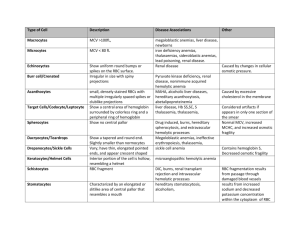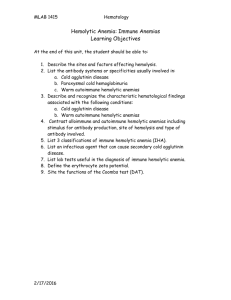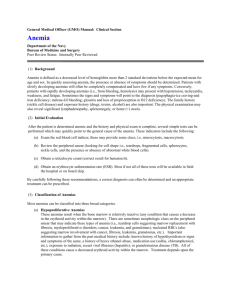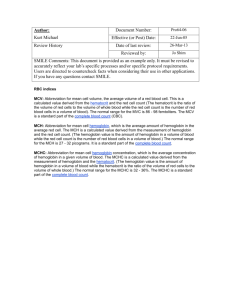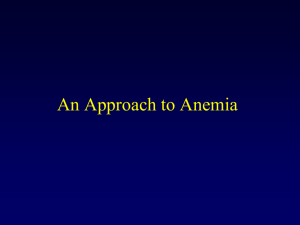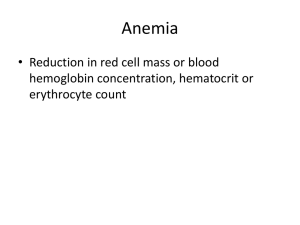investigarea ecgilibrului eritrocitar anemii si
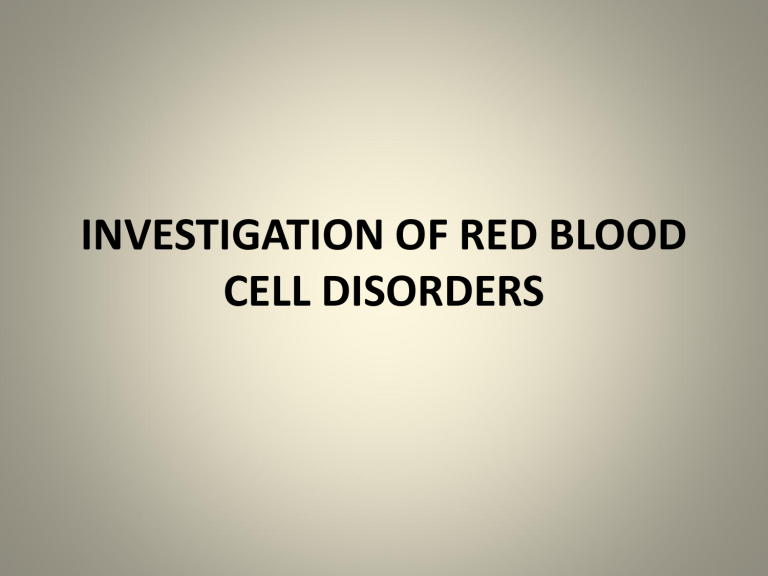
INVESTIGATION OF RED BLOOD
CELL DISORDERS
INVESTIGATION OF RED BLOOD CELL
DISORDERS
- Modification in the number of erythrocytes
(polycythemia, anemia)
- Normal number with abnormal components
INVESTIGATION OF RED BLOOD CELL
DISORDERS
Screening Tests
DETERMINATION OF HEMATOCRIT (PCV)
ESTIMATION OF HEMOGLOBIN
TOTAL RED CELL COUNT
RED CELL INDEXES
EXAMINATION OF PERIPHERAL BLOOD SMEAR
Determination of hematocrit
Ht – ratio of the volume of packed red cells to the total volume
-most precise investigation with the smallest error
Principle: anticoagulated blood is drawn into a hematocrit tube and centrifuged
Macro-method: venous blood in Wintrobe tubes
Micro-method: using capillary tubes.
Values: men=45%+/-5% women=41%+/-5% children =38%+/-5% new born=54%+/-5%
Determination of hematocrit
- Normal PVC with decreased absolute red cell volume in hemoconcentration after hemorrhages
- Decresead PCV in anemias, hyperhidratation
- Increased PCV polyglobulia, hypovolemia
Estimation of hemoglobin
The Hb content can be estimated by:
- Visual colorimetry (Sahli method with acid hematin)
- Photoelectric colorimetry: Hemoglobincyanide
Oxyhemoglobin method
- Spectrophotometry
Normal values: men =14-17g/100ml women =12-15g/100ml children =12-14g/100ml new born=25-16g/100ml
-
Hb and Ht are screening tests with which the investigation are begun.
Hb under 12 g/100 in women or 14g/100 in men and Ht under
36% in women or 39% in men indicate olygocitemia. Next step is counting erythrocyte.
Total red cell count
-automated counting
-visual counting Thoma sau Burker-Turk counting chamber
Normal
-men = 4.7mil/mm3
-women =4.2mil/mm3
-new born=5.5mil/mm3
-children = 4.7mil/mm3
Increase: false polycythemia (decrease of plasma volume, stress) true (new born, polycythemia vera, COBP)
Decrease: false in hemodilution or real in anemias
Red cell indexes
- Mean cell volume
MCV= PCV/RBC (Normal 82-92 fl)
- Mean red cell hemoglobin
MCH= Hb/RBCx10 (25-33pg)
- Mean cell hemoglobin concentration
MCHC= Hb/PCVx100 (30-35 g/dL)
Red cell indexes
Macrocytic anemias:
MCV increased, MHC increased, MCHC normal or diminished.
Mycrocytic hypochromic anemias:
MCV diminished, MCH diminished,MCHC diminished.
Examination of peripheral blood smear
- Increase variation in size and shape anisocytosis and poikilocytosis
(micro- iron deficency, hemolitic anemias, sideroblastic anemic; macro chronic - liver disease,megaloblastic anemias, aplastic anemias)
- Reduced or unequal hemoglobin content hypochromasia (iron defincency, thalassemias) or hyperchromasia (megaloblastic anemias)
- Shape changes: spherocytosis, sickle cells, acantocytosis
Analitical tests
RETICULOCYTE COUNT
BONE MARROW SMEAR EXAMINATION
ANALITICAL TESTS FOR HEMOLYTIC ANEMIAS
ANALITICAL TESTS FOR HYPOCHROMIC
ANALITICAL TESTS FOR MEGALOBLASTIC ANEMIAS
RETICULOCYTE COUNT
- Juvenile red cells
- Counting the reticulocytes from blood sample corresponding for
500 erythrocytes, the normal range should be 0.5-1% (20-
80.000)
failure to produce ret. Inappropriate count, hyperproduction – hemolyasis
Bone marrow biopsy with M/E ratio modified in infections, leukemoid reactions, neoplasic proliferation, erythroid hyperplasia, ineffective erythropoiesis.
Analytical tests for hemolitic anemia
Increased red cell destruction:
Extravascular:
Hyperbilirubinemia
Decreased or absent Haptoglobin (Hp)
Increased plasma hemoglobin
Intravascular:
Methemalbumin
Urine:
Extravascular: increased urobilinogen,hemosiderinuria
Intravascular hemoglobinuria
Increased red cell production:increased reticulocyte, erythroid hyperplasia and polichromatophilia.
Analytical tests for mycrocytic hypochromic anemias
Serum iron
Total iron binding capacity
Serum ferritin
Bone marrow examination
Analytical tests for macrocytic anemias
Bone marrow examination
Serum vitamin B12
Serum folate
Vitamin B12 absorbtion
